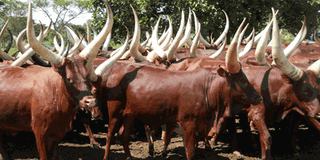Prime
Farmer's Diary: Here is why you should not write off local cattle

With good care, local animals grow fast, and they are easier for our local farmers to maintain than the exotic breeds.
Anyone who read Fred Muzaale’s article in last Wednesday’s Daily Monitor probably has an idea about the kind of decisions farmers often take. “Is it economically viable to keep local breeds of cattle?” screamed the article’s heading.
According to the article, some farmers in Kayunga sub-county want to switch from keeping local cattle to rearing exotic cattle from which they hope to get more milk to sell.
Farming is about taking decisions and sometimes one farmer’s decision may not be the best for the rest.
Basically, we all aim at satisfaction with what we do. We have to weigh the value of the resources we use against the value of what is finally produced. And if no profit is made, then we have no satisfaction, and therefore we take some appropriate decisions.
There is something about local animal breeds that we should not lose sight of. They are less prone to the common diseases caused by local parasites and therefore more manageable to the majority of smallholder farmers who do not always have the cash handy to call in a vet doctor. They are easier to purchase as they generally cost less.
We also have to factor in the different reasons why farmers keep animals. Getting milk is only one of them. One measure of adjusting to risk and uncertainty in farming is diversification.
Some farmers prefer “not to keep all their eggs in one basket” and grow crops alongside animal husbandry. When a farmer sells all his 20 local animals and buys some two Friesian cows to get enough milk, he will have much less cow dung from just those two animals to use as manure if he is also a crop farmer.
With good care and right pasture, local animals grow relatively fast and a farmer who grows a crop such as coffee or bananas will consider their value not so much in terms of milk yield but rather in terms of their manure’s contribution to increased coffee or banana production.
It is local animals that form the basis of African agriculture and a sudden departure from them might not be good for our poverty reduction efforts. Take, for instance, the case of Evelyn Mpumwire and her husband Pius Turamyomwe who were once among the poorest families at Kitabo Village in Lyantonde district.
Ms Mpumwire took a loan of Shs100,000 from an anti-poverty NGO and bought a young Ankore bull, which the family sold at Shs270,000 after some months. They later bought an in-calf at Shs270,000, which produced a healthy calf. The two animals turned out to be so good that a rich man offered to pay Shs1.2m for them. Now the couple have moved out of the banana-fiber-thatched little house in which they lived and have constructed a new albeit modest house with an iron roof.
We keep taking decisions because there are so many variables that are beyond our control as farmers. We have new crop and animal diseases, we have a confusing weather pattern, and we are not always sure about the prices at which we shall sell our products.
Nor do we have any control on the prices of inputs such as fuel, fertilisers, veterinary drugs, or pesticides. What is profitable today may not be so profitable in the next few years. Sometimes milk prices fall and the dairy farmer has to come up with a decision. What works for a farmer in one area might not work for a farmer in another area.
Local cattle breeds still have an important role in the economy of our country despite some of our leaders viewing them as outdated and economically inefficient.
A new book, “The Future of Livestock Production in Africa’s Dry Lands” published by two international development organisations, the International Institute for Environment and Development (IIED) and SOS Sahel International UK, has some interesting revelations about traditional livestock.
Edited by Helen de Iode, the book says, “In Kenya, traditional livestock raised by pastoralists is said to be worth $800m a year. Local cattle trekked for over 450km from Southern Somalia account for 26 per cent of the beef consumed in Kenya, 16 per cent of which is consumed in Nairobi. Uganda’s pastoralists and smallholder livestock producers contribute 8.5 per cent of the country’s total GDP. The traditional livestock sector in Tanzania produces 70 per cent of the country’s milk, which was 770 million litres in 2006.”
According to the book, the African Union and other regional bodies such as Comesa, Ecowas, and Igad are recognising the huge benefits to be reaped from supporting local livestock. “And the good news is that it does not require huge financial investment; it requires refreshed thinking and clearer understanding.”
The choice is yours.




